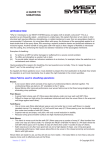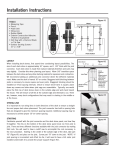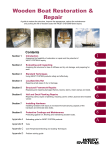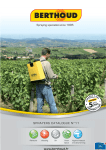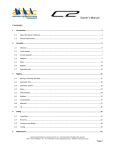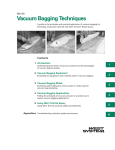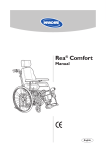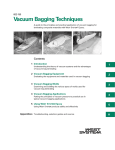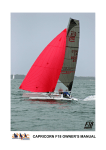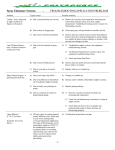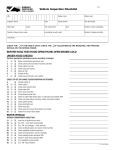Download A Guide to Sheathing
Transcript
A GUIDE TO SHEATHING INTRODUCTION “Why is it necessary to use WEST SYSTEM epoxy and glass cloth to sheath a structure?” This is a question we are frequently asked – sometimes on a daily basis. We explain that when a hull, deck or other structural part requires stiffening, strengthening, or added resistance to wear, then an epoxy/glass sheath is recommended. Furthermore, by using glass fabric with epoxy, the thickness of the epoxy/glass applied is at least double that of the epoxy alone, thus ensuring a superior protective barrier and enhanced resistance to moisture increase. Another benefit of using glass cloth with epoxy is a degree of flexibility is introduced into the coating thus enhancing the impact and abrasion resistance of the epoxy/glass membrane. Examples of sheathing: (i) (ii) (iii) To reinforce a GRP hull either damaged or suffering from a severe osmotic problem. To stiffen and strengthen a wooden hull or deck. To provide better impact and abrasion resistance to a structure e.g. below the waterline or on centreboards and rudders. Having explained the reasons for sheathing, the next questions are normally, “How do I apply the glass fabric?” and, “Is this something I can do?” So regularly do these questions occur, it was decided to prepare this short publication to illustrate how simple the operation is and, most importantly, how to select the right materials in the correct quantities. Glass Fabrics used in sheathing operations Biaxial: two layers of unidirectional fabrics stitched together. (+ and – 45o to the Oo plane gives the orientation of the two layers) Plain Weave: woven glass fabric strands of fibre are woven in a “square” pattern, one set of fibres in Oo plane, the other in 90o plane, fibre strands woven one under and one over. Twill Weave: Woven glass fabric as plain weave but fibres are woven two or three under, one over. Crowsfoot Weave: The 745 fabric has 80% of the fibres in the 90o plane and 20% in the Oo plane. The woven fabric is easier to use, as it will wet-out more readily – the biaxial fabric is more heavy duty and requires more work to effectively wet-out the fibres. We do not list Chopped Strand Matt, (CSM), as this type of glass is designed for use with polyester resin and provides little benefit when used with epoxy. Estimating Quantities Required When applying sheathing it is important to correctly estimate the material required. (i) (ii) Coating: Sheathing: Fairing: Allow 15 to 20% more in addition to the surface area for the glass quantity Use the following estimates for calculating the quantity of epoxy required: 135g of epoxy to coat 1m2 Allow the same weight of epoxy as the fabric. ie. if the cloth weighs 300 g/m2. Allow 300g of epoxy per m2, allow approximately 15% extra for wastage. 600g mix of WEST SYSTEM epoxy/407 Low Density Filler will provide 1mm thickness over 1m2. (600g mix = 240g 407 + 360g 105/205). Version A 05/04 Page 1 Selecting the Correct Fabric There is a wide range of fabrics available in the market place. Within the WEST SYSTEM product range we have included the most widely used and easy-to-handle fabrics. Given below are details of the glass cloths and their potential uses: Style 736 738 739 740 741 742 743 745 746 Weight 300 g/m² 610 g/m² 450 g/m² 135 g/m² 200 g/m² 200 g/m² 280 g/m² 190 g/m² 260 g/m² Construction +/-45O Biaxial +/-45O Biaxial +/-45O Biaxial Plain Weave Twill Weave Plain Weave Twill Weave Crowsfoot Woven Roving Uses Clear Laminate General sheathing will add some structural strength Almost General sheathing applications structural fabric No General sheathing applications structural fabric No Lightweight fabric to provide general sheathing Yes General purpose fabric Yes General purpose fabric Yes General purpose will add some structural strength Almost Ideal for sheathing centreboards and rudders Yes General purpose fabric Almost Why use Epoxy? A specially formulated marine grade epoxy offers many advantages over both base epoxy products and polyester resins (fibreglass resin). A formulated marine epoxy will tenaciously bond to the substrate whether it is wood, GRP or metal and will provide superior bond strength and toughness. Low cost base epoxies and polyester resins do not have the same ability to resist moisture ingress and may, in time crack and peel from the underlying surface. The choice of resin is crucial, selecting a formulated epoxy product will, in the long term reduce costs and maintenance. As a general rule WEST SYSTEM epoxy will be used in most sheathing operations. However, if the area to be sheathed is large, or a number of heavy weight multi-axial fabrics are used, the PRO-SET laminating epoxy should be considered. For applying light-weight fabrics, WEST SYSTEM 105 Resin with 205 Hardener can be used to a working temperature of around 20/22oC. Above this temperature, or if a large area is to be sheathed, use 206 Slow Hardener. If you require assistance in selecting the correct hardener please contact our Technical Support Group. Working Conditions/Environment It is important to ensure the correct working conditions are maintained when sheathing. At warmer temperatures the resin and hardeners are more easily dispensed, more readily mixed and much easier to apply to the substrate. In addition, due to the lower viscosity of the epoxy at warmer temperatures, the fabric is easier to wet-out. Working indoors with adequate heating is the ideal situation but, unfortunately, this is not always possible. Erecting a tent around the boat and providing warm dry heat will be adequate. Storage of the resin and hardener is important, keeping both components in a warm dry area or using a hot box (drawing available) to store the epoxy will ensure the components are easy to use. 1 2 3 4 5 Work undercover Provide warm dry heat Try to maintain a temperature of between 18 to 25oC Store the products in a warm dry area Warm the surfaces to be coated to a similar temperature to the workshop to aid in applying the epoxy and when coating wood, this will eliminate any “out-gassing” from the timber. Page 2 Surface Preparation Always ensure surfaces to be coated are clean, dry and thoroughly abraded (80 grit paper). (i) Oily Timber In addition to the above, degrease oily timbers, such as teak, using a volatile solvent, for example, pure acetone. Furthermore, sand across the grain to thoroughly roughen the timber face of hardwoods. (ii) Metal The minimum requirement is to degrease, abrade back to bright metal and degrease again. Either grit or sandblasting is the best method for surface preparation. Apply first coat of epoxy within 2 to 3 hours after second degrease to avoid oxidation of the metal surface. (iii) Metal Alloys The preparation given above in (ii) is the minimum requirement, however, it is recommended that alloys are chemically etched in order to provide the best adhesion. Seek advice from WRA Filling & Fairing Fill & fair the surface to be sheathed using WEST SYSTEM epoxy and 407 Low Density Filler mixed to a peanut butter consistency. Applying an epoxy fillet to any external angles will allow the fabric to be more easily applied. When the epoxy/filler has hardened, sand fair before application of the epoxy/glass sheath. (We would recommend applying peel ply tape over the fillet joint as this would eliminate the need to sand before applying further epoxy). Apply epoxy without filler to the area to be filled. Trowel epoxy mixed with 407 Low density Filler to peanut butter Consistency into voids. Applying an epoxy fillet to any external angles will allow the fabric to be easily laid. Page 3 A GUIDE TO SHEATHING Applying Glass Cloth There are two methods for sheathing – the “dry” and “wet” method. There is a variation to these methods, wetting out the fabric either on a flat polythene covered table or by using our impregnator, rolling the wet fabric on a plastic pipe and then laying out the fabric onto the surface. Squeegees are then used to remove air and any excess epoxy from underneath. This variation is particularly useful when sheathing large areas. The Dry method For best results the surface must be pre-coated with one or two coats of epoxy, allowed to cure and sanded (60-100 grit). This will reduce the problems associated with “out gassing” under the fabric, by sealing a porous material such as wood. If sheathing the hull the surface would be coated and faired prior to applying the fabric. The dry method is ideally suited to sheathing flat areas, decks etc, or inverted hulls. Generally, the dry method would only be used with lighter weight fabrics up to 300 g/m2. Above this weight, or when using multiaxial fabrics it is difficult to wet through the cloth. (i) Cut fabric to correct lengths and roll onto cardboard or plastic tubes. Position fabric, if necessary using either staples, tacks or tape to temporarily hold the cloth in position. (ii) Mix enough epoxy to wet out the fabric. On flat surfaces pour epoxy directly onto the fabric in small puddles and work epoxy into the fabric using plastic squeegees and/or foam rollers to removed trapped air. Caution: Do not over work the fabric as this will disturb the weave of the cloth. Do not use excess resin/ hardener as the fabric will “float” on the epoxy, i.e. the glass cloth must be in contact with the surface.. (iii) Ensure the cloth is thoroughly wetted out. Do not leave any “white” spots – these are areas of dry fabric. (iv) When the cloth has a dull semi-matt finish it is wetted out. If the surface appears shiny, too much epoxy has been used. (v) Move onto the next piece of fabric, either butting or overlapping the fabric. If using WEST SYSTEM 744 280 g/m2 Twill cloth this fabric has tapered edges producing clean overlapped joints. NOTE: If working on uncoated wooden surfaces, ensure the timber is warmed before application of epoxy. Remove the heat source before applying the epoxy. This will eliminate the “out-gassing” produced when expanding air is released from the wood fibres. If the surface is to be clear finished, use lighter weight fabrics. Although one layer of 280 g/m2 Twill fabric will become transparent when wetted out, the weave of the cloth may still be visible. Wet Method Once the surface is prepared and the glass cloth cut to size: (i) Roll a heavy coat of epoxy onto the surface. (ii) Carefully unroll the glass cloth into position over the wet epoxy. Surface tension will hold the fabric in position – if applying to vertical or overhead surfaces, allow the epoxy to become a little tacky, say after 30 to 45 minutes as this will help to hold the fabric in position. Work out wrinkles and excess air using either a plastic squeegee or foam roller. (iii) Re-apply epoxy to any dry areas. (iv) Squeegee out any excess epoxy. (v) Once fabric is wetted out move onto next section. When using the wet method, it may be advantageous to cut the fabric once wetted out. This will ensure accurate placement of the fabrics and stability of the cloth from the roll. Use an adapted clothes rail, taught, rope or a broom handle to allow free dispensing of the cloth from the roll. Clean scissors etc, with WEST SYSTEM 850 cleaning solvent. Version A 05/04 Page 4 A GUIDE TO SHEATHING Joining Fabric Trim the excess and overlapped cloth after the epoxy has reached its initial cure. The cloth will cut easily with a sharp utility knife. Trim overlapped cloth as follows: (a) Place a metal straight edge on top of and midway between the two overlapped edges. (b) Cut through both layers of cloth with a sharp utility knife (c) Remove the top-most trimming and then lift the opposite cut edge to remove the overlapped trimming. (d) Re-wet the underside of the raised edge with epoxy and smooth into place. The result should be a near perfect butt joint, eliminating double cloth thickness. The disadvantage of joining fabric in this way is that the knife will mark wood and this is not suitable when a clean finish is required. However, a lapped joint is stronger than a butt joint, so if appearance is not important, it may well be advisable to leave the overlap and fair in the unevenness after coating. Any remaining irregularities or transitions between cloth and substrate should be faired by using an epoxy/ filler fairing compound if the surface is to be painted. Any fairing completed after the final glass cloth layer should receive several additional coats of epoxy over the faired area, once surface preparation has been completed. If using WEST SYSTEM 743 280 g/m2 Twill fabric, a perfect joint is achieved as this cloth has tapered edges. When a clear finish is desired this fabric is a good option. Using Peel Ply The use of peel ply in the sheathing process is extremely important. The closely woven nylon cloth is a release fabric, to which epoxy will not adhere and is applied as the last layer of the sheathing process. The Peel Ply fabric is thoroughly wetted out and must be in full contact with the underlying laminate. Why use peel ply? These are the major advantages of using the cloth. (i) (ii) (iii) (iv) (v) The epoxy/glass sheathing is evenly consolidated as more pressure can be applied without disturbing the fabric. Excess epoxy is brought to the surface and is removed from the laminate The epoxy/glass surface is protected and any amine blush will occur on top of the peel ply. Furthermore, the Peel Ply will allow walking over the sheathed area as the Peel Ply will protect the underlying epoxy/glass sheathing. When the Peel Ply is removed the textured surface will not need sanding, thus allowing further layers of glass/epoxy, fairing compounds or coatings to be applied. (Only remove Peel Ply just before the application of subsequent coating). Overlap joints, and stitching on multiaxial fabric, are feathered out by using Peel Ply. The additional cost of using peel ply is far outweighed by the reduced labour involved in sanding a cured epoxy coated surface. The Peel Ply can remain on the surface for a long period of time as it will still be easily removed, thus protecting the epoxy/glass sheathing. Peel Ply is applied as the last layer in the sheathing process, or the last layer applied in a single day. Layout the fabric on the epoxy/glass surface. Wet out the peel ply using foam rollers and/or squeegees. There will probably be enough excess epoxy in the laminate to thoroughly wet-out the fabric, however, if there are any dry areas wet-out by applying more epoxy. Overlap the peel ply where necessary. Important: Ensure there is an un-wetted edge of Peel Ply. When cured this dry edge will ensure the Peel Ply is more easily removed. Version A 05/04 Page 5 A GUIDE TO SHEATHING Overcoating Sheathing If not using Peel Ply, the last layer of epoxy/glass should be either: (i) Or (ii) Overcoated with one or two coats of epoxy to fill the weave of the fabric, but only when the epoxy/ glass laminate is touch dry. Filled with one application of WEST SYSTEM epoxy/407 Low Density Filler. By completing either one of the above, when the epoxy is washed and sanded prior to overcoating the sanding ought not to cut through to the epoxy/glass laminate. If applying epoxy/filler, once cured and sanded, two further coats of epoxy should to be applied. Please refer to the WEST SYSTEM User Manual and Product Catalogue for further information. Version A 05/04 Page 6






